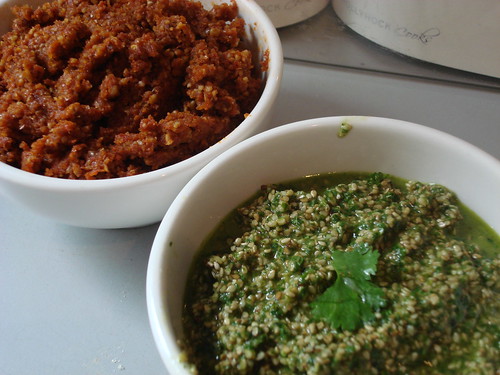My son, the Bean, has taken a keen interest in taking pictures with our camera (a Sony Cybershot 10.1 MP). Some of his photos are very good (as good as an adult might take). Most are blurry, since he tends to move to the next shot as soon as his finger is off the button. All of them are fascinating because they really give a good idea of how a three year old views our world.

Along with taking photos of his family members, the Bean's photos have three main themes: "Looking Up", "The Toy Series" and "Textures and Patterns". He even knows to put the strap on his wrist before he takes pictures, and when he reviews them. ( I love our camera, and really don't want to have to replace it for a while!). It's further proof to me that he watches what I do - and what parent doesn't like it when their child wants to be just like them?
Tonight was our turn to cook for the weekly dinner with BIL and GIL. While the Bean snapped photo after photo, I cooked up a dish I had been dreaming about. Two kinds of pasta, a package of squid, some leftover onions, parsley, garlic, red wine and tomato sauce and voilà! To help me along, I used a combination of a recipe from Bon Appétit for squid in red wine and tomato sauce, and one from a Greek cookbook my dad used to own.
At dinner it was BIL's turn to spill the wine. "Too much time spent with this one," was his explanation, pointing to GIL.

We all agreed the Bean had talent, and should get his own camera.
Squid in Red Wine and Tomato Sauce, Nikos Style
serves 4
(recipe sources: epicurious.com and Greek with Gusto!)
Ingredients
1/4 cup olive oil
1 medium onion, chopped
1 pound cleaned squid, tentacles left whole, bodies cut crosswise into 1/2-inch rings *
1 28 oz can of tomatoes, chopped
3 garlic cloves minced
1/2 cup dry red wine
1/4 cup chopped fresh parsley
1 tsp dried and crushed oregano or 2 tablespoons fresh
2 tablespoons tomato paste
1/4 teaspoon dried crushed red pepper
equal portions of whole wheat and spinach fettuccini
* I used a package of pre-cut frozen squid pieces, It worked fine.
Preparation
Put a pot of water on to boil. When the water is boiling, add the pasta and cook to al dente. While the pasta is cooking, heat olive oil in heavy large skillet over medium-high heat. Add onions and sauté until golden, about 7 minutes. Add squid and sauté 1 minute. Add tomatoes, garlic, wine, parsley, oregano, tomato paste, and crushed red pepper. Simmer until squid is tender and sauce thickens slightly, stirring occasionally, about 5 minutes. Season to taste with salt and pepper.
Remove the sauce from heat. Serve the pasta in bowls and spoon the sauce overtop. Serve immediately.
This recipe has been submitted to Presto Pasta Nights, started (and hosted this week) by Ruth of Once Upon a Feast. You, too, can take your turn hosting Presto Pasta Nights. Check out the Presto Pasta Nights website for more details, and other great pasta trivia.














